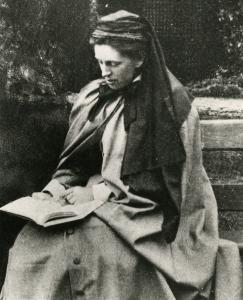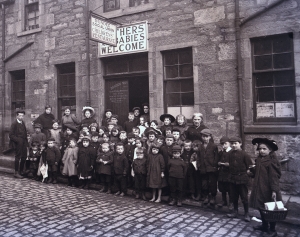Maws & Bairns: Maternal & Child Health in Tayside
The Dundee Social Union
Sanitary improvements following the Public Health (Scotland) Act of 1867 had helped to reduce the incidence and mortality of smallpox, typhus, scarlet fever, typhoid and tuberculosis. However, the infant mortality rate (the number of deaths under one year of age for every 1,000 births) remained worryingly high in Dundee. In 1912, the Medical Officer of Health’s Report detailed 662 infant deaths in Dundee, an infant mortality rate of 159. Today, the nearest figure to this is in Afghanistan where estimated infant mortality rate is 122. It was not until 1923 that Dundee’s rate fell below 100. The current UK rate is 5.
 In 1888 a group of public-spirited citizens, concerned about the adverse effect on health caused by poor housing conditions, formed the Dundee Social Union. The key figure in this initiative was Miss Mary Lily Walker (see photo, left), whose concern for the poor of the city had led her to give up a promising career in science and turn to social work. Encouraged and aided by several of the professors at University College, Dundee, she built up a small band of women volunteers to tackle the sizeable burden of housing and health issues in Dundee.
In 1888 a group of public-spirited citizens, concerned about the adverse effect on health caused by poor housing conditions, formed the Dundee Social Union. The key figure in this initiative was Miss Mary Lily Walker (see photo, left), whose concern for the poor of the city had led her to give up a promising career in science and turn to social work. Encouraged and aided by several of the professors at University College, Dundee, she built up a small band of women volunteers to tackle the sizeable burden of housing and health issues in Dundee.
In 1904, largely on the initiative of Miss Walker, the Dundee Social Union published a highly influential Report on the health of 1,000 children drawn from schools in different parts of Dundee. This showed clearly the deplorable state of children’s height, weight and health in the slum areas, and acted as a catalyst for a number of initiatives.
The greatest evil disclosed by the Medical Officer of Health Report in 1912 was the high rate of infant mortality. This was thought at the time to be caused by a complex mix of social and economic factors, but most importantly infant feeding. In his report, the Medical Officer of Health was clearly concerned about the adverse effect on children of the mothers’ work in the mills and factories.
 Recognising that low wages of unskilled males could not provide necessary nourishment for the mother if she stayed off work, the Dundee Social Union opened an experimental Restaurant at the West Port in 1906, the first of its kind in Britain (see photo, right). Here breakfast and dinner were supplied to any mother nursing her child, free of charge for the first three months of the child’s life, as long as the infant was entirely breast-fed, the mother stayed away from work, and the child was brought to be weighed each week. Its success led to further Restaurants opening in Dundee, home visits for all new babies, infant clinics, milk depots and a School for Cripple Children. With the benefit of the Medical Officer of Health Dr Templeman’s fore-sight, the City took over Miss Walker’s scheme and developed the first Infant Health Department in Scotland.
Recognising that low wages of unskilled males could not provide necessary nourishment for the mother if she stayed off work, the Dundee Social Union opened an experimental Restaurant at the West Port in 1906, the first of its kind in Britain (see photo, right). Here breakfast and dinner were supplied to any mother nursing her child, free of charge for the first three months of the child’s life, as long as the infant was entirely breast-fed, the mother stayed away from work, and the child was brought to be weighed each week. Its success led to further Restaurants opening in Dundee, home visits for all new babies, infant clinics, milk depots and a School for Cripple Children. With the benefit of the Medical Officer of Health Dr Templeman’s fore-sight, the City took over Miss Walker’s scheme and developed the first Infant Health Department in Scotland.
The passing of the Maternity & Child Welfare Act in 1918 initiated the growth of child welfare services as we know them today, and led to the widespread availability of specially trained health visitors to provide advice and instruction in child care to those who most need it.
Mary Lily Walker was pivotal in establishing a Dispensary and Clinic for women in the early 1890s. The objective was to offer to the very poor who desired it an opportunity of consulting women practitioners and of obtaining necessary medicines at the smallest possible cost. Although a great success, it was soon realised that a small hospital was also required for those requiring gynae-cological operations, not only for the very poor but for anyone unable to pay the fees of a private nursing home. Largely due to Miss Walker’s endeavours, a six-bed Private Hospital for Women was opened in Seafield Road in 1895, which by all accounts was more like a home thanks to the care given by Matron McKenzie.
In 1913, thanks to the generosity of the Sharp family of Hill of Tarvit in Fife, the renamed fourteen-bed Dundee Women’s Hospital & Nursing Home moved to a splendid new site at Elliot Road in the West End. One of the beds was endowed in memory of Miss Walker, who died the same year. In later years it became an annexe of Dundee Royal Infirmary for convalescent and radiotherapy patients, and has now been converted into luxury apartments.
Images courtesy of University of Dundee Archive Services and Dundee Central Library, Local History Centre